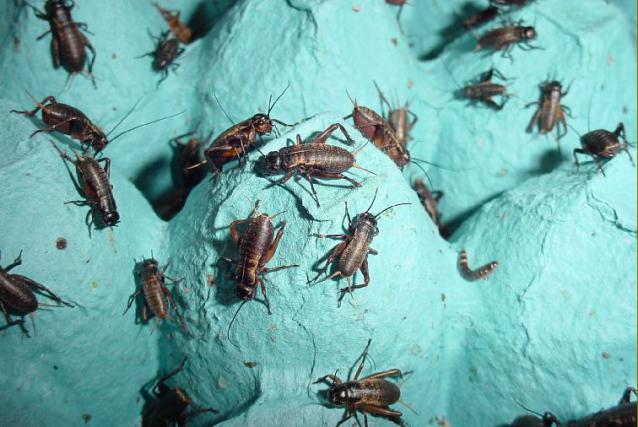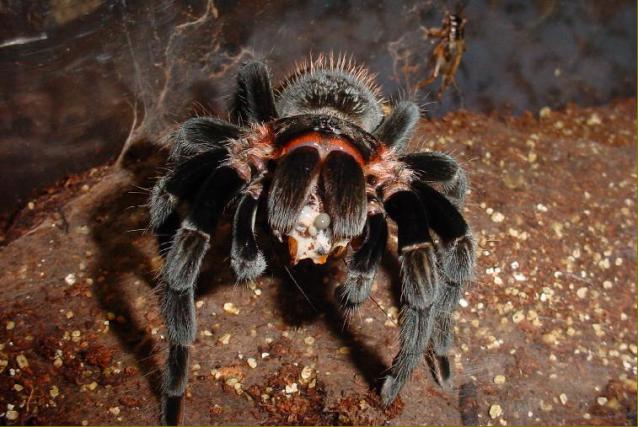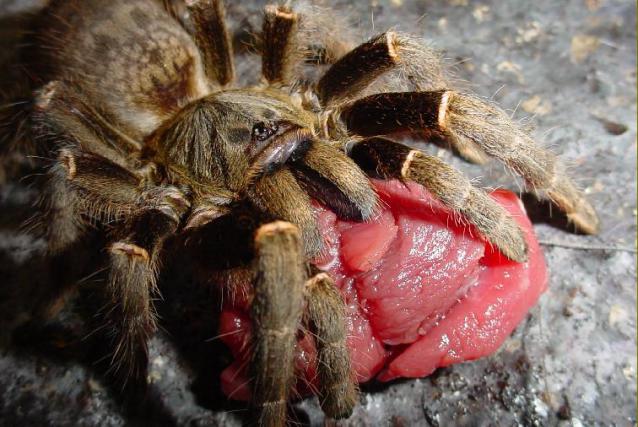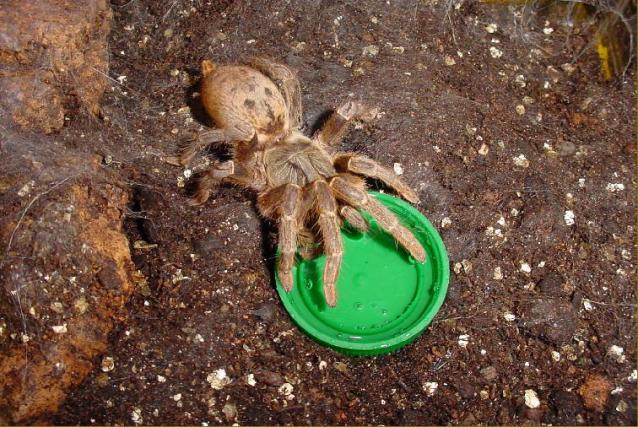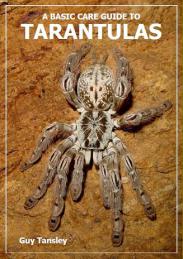
FOOD AND WATER
Tarantulas mainly attack live prey but
will occasionally accept a piece of raw fat free beef if it is dangled from a piece of string to simulate movement. Tarantulas gain a lot of nourishment from beef and even the largest spider will
spend 24 hours consuming a piece. Their main prey, however, is small invertebrates such as crickets, moths and flies etc.
CRICKETS: These are probably the most widely used source of live food
by keepers as they are nutritious and fairly easy to rear. The cricket container must be well ventilated as they are extremely susceptible to damp conditions. In the bottom of the container there
should be some screwed-up newspaper and old egg cartons for the crickets to hide in. Food consists of fish pellets, dry dog biscuits or cereal - the better the diet of the crickets, the better the
diet of the tarantula. Water should be provided by either using a shallow container with damp tissue paper or freshly cut potato which must be replaced daily. A temperature range between 20 - 30oC is
ideal for breeding your own supply of crickets but they will survive at lower temperatures. If a large number of adult crickets is kept, breeding is a simple affair. Shallow containers should be
filled with damp compost and placed in the container allowing females to deposit their eggs. These containers should be removed on a regular basis and placed preferably in a heated area. After a few
weeks, the tiny micro crickets will emerge and these can then be housed in a smaller container. Water is essential for micro crickets as they are prone to desiccation. Repeating this process for a
few months will result in a constant supply of crickets of varying size to suit the size of your spiders. A well kept cricket culture will last for many weeks and provide a highly beneficial food
source.
FLIES: These are eagerly accepted by
arboreal species as in their natural environment, flying insects would form a large part of their diet. The fly larvae (maggots) are commercially available from fishing bait stores and are relatively
inexpensive. The maggots should then be placed in a large jar with a tight fitting ventilated lid and fed on a mash of dog biscuits. Eventually the maggots will pupate and then can either be put into
a fly cage until emerging or be placed into a well ventilated box in the refrigerator - this allows their development to be slowed and they can be used when required. Different species of fly should
be provided depending on the size of the tarantula. For example: blow flies (blue bottles) for large juveniles to adults and house flies and fruit flies for
spiderlings.
MEALWORMS & WAXWORMS: These make a good additional food source. Care must be taken as they can
sometimes burrow into the substrate if the spider doesn't accept them immediately and may cause problems when the spider is moulting. Adult beetles and moths of these worms can also be
used.
You can collect other insects from outdoors such as moths but it is best to keep them for at least 24 hours before feeding them to the spider. This is because a food source collected from the wild may have been in contact with pesticides which could harm your spider. Obviously bees, wasps and anything that can fight back should be avoided.
This depends on the individual. I offer one or two crickets to my tarantulas once a week but bear in mind that a hungry tarantula will take four or five crickets in one feeding so the amount offered should be according. Tarantulas can sometimes go through periods of fasting (when approaching a moult, for example) and this is especially true in adult specimens. It is not uncommon for a spider to stop feeding for several months but if it is plump and active, there is little cause for concern. Fresh water must always be available however, especially when the spider is in pre-moult.
The tarantula must have access to clean drinking water at all times. This can be provided using any shallow container. Lids from small jars or screw tops from bottles are adequate but the container must be left open so that the spider can drink freely. Do not use items such as tissue or cotton wool in the dish as these can cause problems for the tarantula. Place some pebbles in the dish to prevent any prey items from drowning and regular cleaning of the dish is important, to remove substrate and food remains etc. Having an open water dish in the tank also helps with humidity and although they can survive long periods without food, without water they will soon die. The container should be shallow enough for the spider to immerse its entire 'chest' in order to drink. Arboreal species prefer to drink from the tank walls so a weekly spray of the surrounding container is necessary. Always ensure that the water dish is topped up regularly as tarantulas may drink a surprising amount in one sitting.
